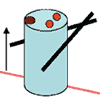Consultations & Comments: A "New" Twist on the Technique of Umbilical Catheterization?
We heard from several readers about a Photo Essay we recently published in our February issue entitled "The Butterfly Technique: A New Method of Inserting an Umbilical Vessel Catheter."1 The authors, Lisa A. Wood, MD, and Mark J. Polak, MD, described modifications of standard catheter insertion techniques that facilitated successful line placement.

We heard from several readers about a Photo Essay we recently published in our February issue entitled "The Butterfly Technique: A New Method of Inserting an Umbilical Vessel Catheter."1 The authors, Lisa A. Wood, MD, and Mark J. Polak, MD, described modifications of standard catheter insertion techniques that facilitated successful line placement.
Most of the feedback was from readers who were already familiar with the method described in the Photo Essay. Here is a smattering of the comments:
"I've used this technique for over 20 years and have taught countless residents and fellows its benefits. Not only does it give better control of the vessels when preparing for catheter insertion, it also allows for limited use of 'umbilical tape.'
"Those who use this technique might want to cross-clamp the umbilical stump more than 0.5 to 1 cm above the skin line. This will make it easier to position the vessels and leave extra length in case of vessel wall perforation."
"The technique detailed was exactly the method that I was taught in 1983 to 1986 at Children's Medical Center and Parkland Memorial Hospital in Dallas. This was the standard technique for inserting umbilical lines in the 1980s. There are hundreds of practicing pediatricians who use this method."
"I published an article on the technique described in your Photo Essay back in 1980. . . ."
"The photos are very good."
We also heard from a reader who was not familiar with the technique. He wrote:
"I have inserted several hundred umbilical catheters, yet I couldn't follow the technique the authors were trying to demonstrate. Please ask them to elaborate?
To this last comment, the authors responded, "It is apparent that the orientation of several of our photos may have been confusing. The drawings here depict the umbilical stump and the proper orientations. We hope these figures will resolve any confusion."
References:
REFERENCE:
1.
Wood LA, Polak MJ. The butterfly technique: a new method of inserting an umbilical vessel catheter.
Consultant Pediatricians.
2006;5:93-95.
Recognize & Refer: Hemangiomas in pediatrics
July 17th 2019Contemporary Pediatrics sits down exclusively with Sheila Fallon Friedlander, MD, a professor dermatology and pediatrics, to discuss the one key condition for which she believes community pediatricians should be especially aware-hemangiomas.